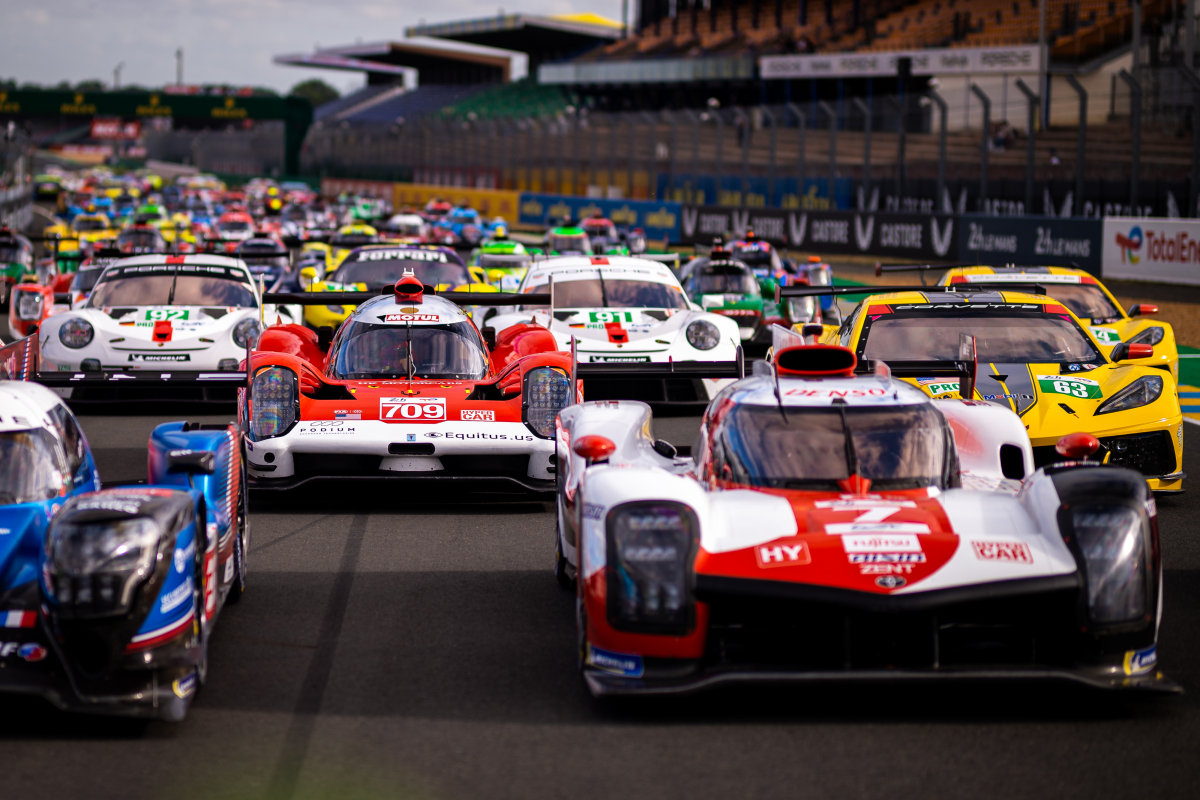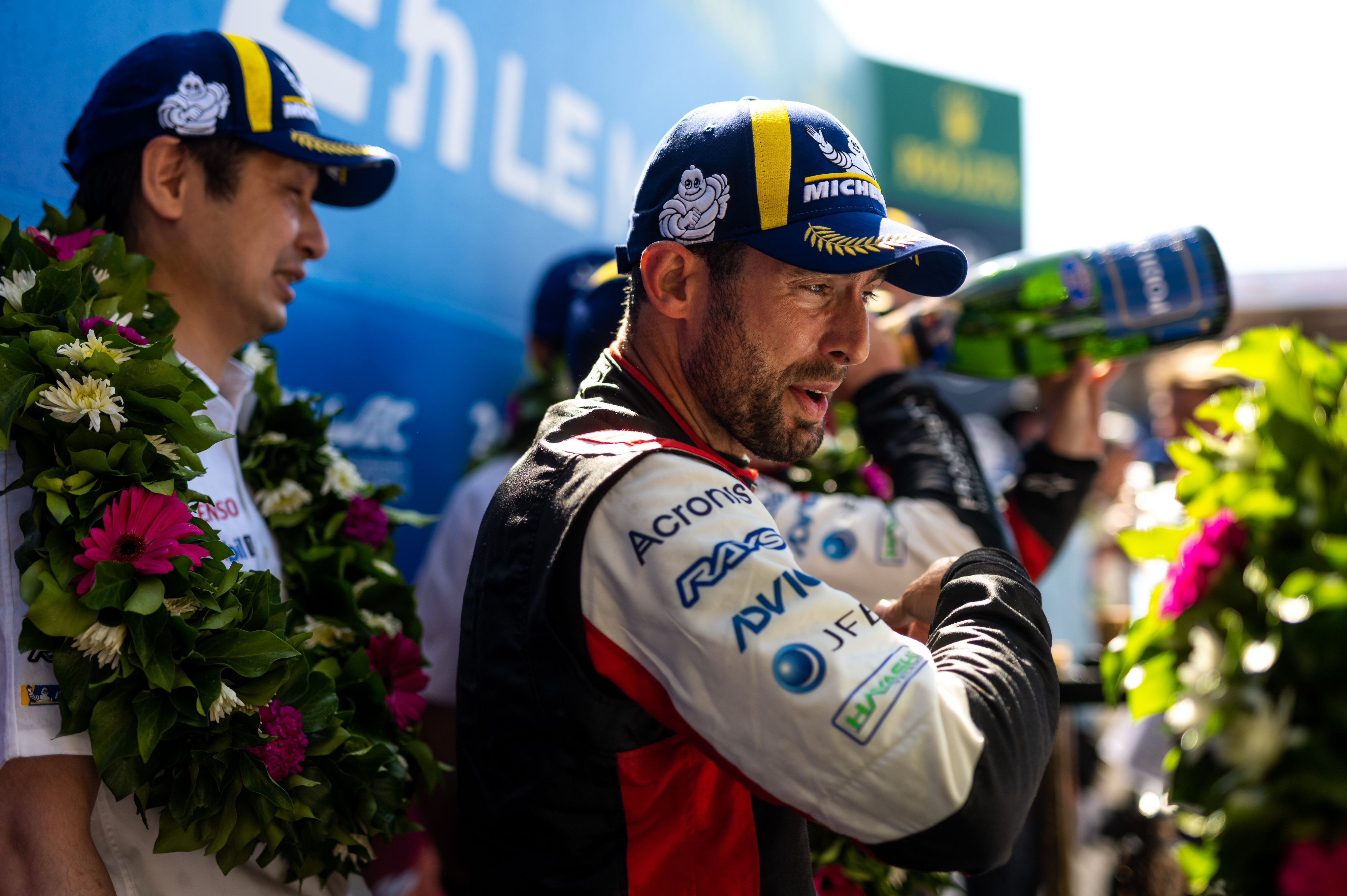
In the fourth of a five part series leading up to the big race from 10-11 June, we outline some intriguing moments, anecdotes, stats and facts from 100 fabulous years of the 24 Hours of Le Mans.

61. DON’T CRY FOR ME: When Jose-Maria Lopez celebrated his win in the 2021 Le Mans 24 Hours it wasn’t just the first time an Argentinian born driver had won the race but remarkably the first time anyone from South American had triumphed.

62. HOODOO BROKEN: Prior to Lopez’s achievement several well-known Argentinians had struggled at Le Mans, even Il Maestro himself, Juan-Manuel Fangio. He took part in four Le Mans’ between 1950 and 1955 but failed to finish any of them. Carlos Reutemann had just one single appearance for Ferrari in 1973 but retired the car at half distance with an engine failure.
63. LONG TIME, NO SEE: The record for the greatest length between Le Mans starts goes to Jean Alesi who made his debut in a Schuppen Porsche 962 in 1989 but then waited 21 years until his second race at La Sarthe. On that occasion he raced for the AF Corse team in GT2.
64. LEGEND AT LE MANS: Lotus design legend Colin Chapman raced twice at Le Mans in his own cars. He shared a Lotus MkIX with Ron Flockhart in 1955 and then a Lotus XI a year later with Herbert MacKay-Fraser. On both occasions Chapman and his creations failed to finish.
65. RACING BOSS: Only one former FIA President has raced at Le Mans. His name was Paul Alfons von Metternich-Winneburg and he took part in the 1956 race aboard his own entered Mercedes 300SL. His race ended after an accident at Tertre Rouge after seven hours. Metternich-Winneburg was president of the FIA from 1975 to 1985.
66. FOOT ON THE GAS: One of the most recognisable innovators of the 1960’s was undoubtably the Rover BRM gas turbine car that raced between 1963 and 1965. The technology used a single centrifugal compressor, a single combustion chamber and a free turbine driving the output shaft, separate from the turbine that drove the compressor. F1 world champions Jackie Stewart and Graham Hill claimed the cars best result of 10th.
67. POLE TO GLORY: The No.8 Toyota in 2018 was only the second car, after the No. 7 Bentley in 2003, to take its first win of the century from pole position. Audi won from 2nd in 2000, Peugeot from 5th in 2009 and Porsche from 3rd in 2015.
68. ROMPS: There have been Le Mans’ where the margin of victory was 10 laps or greater. The first such case was in 1927. After several of the favoured cars crashed together in the evening at Maison Blanche the remaining healthy Bentley had no opposition, winning by 20 laps or about 345 kilometers on the then 17.3 km. circuit.
69. PORSCHE STEAMROLLER: This gap, in terms of laps, was repeated exactly 60 years later in the all-Porsche affair of 1987. All but one of the 962s suffered from the same electronic issues in their fuel management system leaving Hans Stuck, Derek Bell, and Al Holbert to stroll home. As the circuit was by now nearly four kilometers shorter the margin by distance was less than in 1927.
70. ATTRITION: The 1970 race was another with a large gap at 15 laps, the field greatly decimated by heavy rain. The last time there was a double digit gap in laps was in 2007 at 10 laps. It was the first instance at Le Mans when Peugeot unsuccessfully challenged Audi.
71. WET! WET! WET!: Of the 90 editions held thus far, 37 of them have experienced some rain during the race itself. In 19 to 23 of these there were only brief showers or longer periods of light drizzle—not enough to significantly alter the outcome or team strategies. However, during the other 14 to 18 years there was either persistent precipitation or short intense cloudbursts which altered the race. The initial such case coincided with the very first race, in 1923.
72. WEATHER PATTERNS: That was repeated in 1927 and then again after a seven year gap in 1935. Rain did not return as a factor until 1951 but that was only a seven race gap given the “intermission” imposed by hostilities. Three other 1950s editions suffered particularly heavy rains (1954, 1956, 1958 as well as 1960) but it was not until 1970 that weather again played a large role. The following two decades featured four years where the rain played some, though not necessarily a decisive role; 1972, 1979, 1980 and 1987. The 1995 race suffered from a near continuous drizzle while the start in 2001 included one of the heaviest downpours ever seen at La Sarthe. More recently, the 2008, 2013, and 2014 dates had variable weather.
73. FLAGGED: It is part of Le Mans folklore that despite some awful weather and the dreadful accident of 1955 the race has soldiered on, with systems of neutralization being employed since 1980. However, this is not entirely true. At the end of the first hour of the 1937 race there was a very serious multi-car accident at Maison Blanche which resulted in the death of two drivers. Marshals waved red flags and several drivers who managed to stop ran back and signalled the rest of the field. Everyone remained in place for about 10 minutes until the injured were carried off and the debris was cleared.
74: SAFETY FIRST: From 1980 through 1995 there were safety car interventions at nine of the races. Then from 1999 through 2022 there has been at least one neutralization every year. The most interruptions took place in 2019 with 15 calls to slow down but the longest neutralization by time was in 2013 when there were 5-1/2 hours of slow running. The cleanest recent race was in 2022 when only one call was made to the safety car for a 25 minute break.
75. BLUE BLOOD AT LA SARTHE: Britain has had several aristocratic racers over the years. Sir Henry ‘Tim’ Birkin, a Third Baronet from Nottinghamshire held the Brooklands Outer Circuit’s lap record in his famous ‘Blower’ Bentley and won the 1931 Le Mans 24 Hours in an Alfa Romeo. Earl Howe, Birkin’s was the entrant and co-driver on the latter occasion, while Peter Mitchell-Thomson, aka: Lord Selsdon, played a vital role in Ferrari’s maiden Le Mans victory in 1949.
76. ‘MARSHALLING’ NIGHTMARE: One of the most bizarre retirements ever at Le Mans was triggered when Toyota’s Kamui Kobayashi slowed shortly after a pit-stop triggering a clutch problem. The No.7 TS050 Hybrid had largely dominated from the start but Kobayashi mistook LMP2 driver Vincent Capillaire waving in enthusiastic support and was mistaken for a pit marshal asking Kobayashi to stop!
77. TOP OF THE DOME: The first car to be constructed in Japan to race at Le Mans was the Dome Zero RL. An extraordinary looking car that featured. Wedged shaped body and cockpit canopy. A quartet of British drivers – Gordon Spice, Tony Trimmer, Bob Evans and Chris Craft drove the cars but they both retired with fuel issues before midnight.
78. PRESEDENTIAL PRESENCE: French President George Pompidou dropped the Tricolore to start the 1972 race which witnessed Matra’s first 1-2 at La Sarthe and the start of a three year period of dominance. The Pompidou link didn’t stop there however as a generation on, his great nephew Xavier raced several times in the 24 Hours.
79. WINNING BY NOT LEADING!: A disqualification saw Signatech Alpine become the first team to win a WEC race despite leading 0 laps, in LMP2 at Le Mans 2018. Toyota repeated the feat overall at the following race in Silverstone, before Project1 won GTE Am at Le Mans 2019 under the exact same circumstances.
80. UNLUCKY BREAK: India’s first F1 driver Narain Karthikeyan was set become his nations first representative in the top category in 2009 when he was teamed up with Andre Lotterer and Charles Zwolsman in a Kolles run Audi R10. However, fate intervened when Karthikeyan fell over the pitwall before the start and dislocated his shoulder. That ensured that Lotterer and Zwolsman completed the race between them, finishing a fine seventh and jettisoning Lotterer in to the factory Audi team and eventual endurance legendary status.
Click HERE for the previous instalment of Le Mans-based facts.